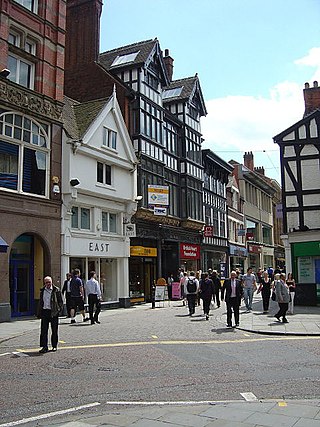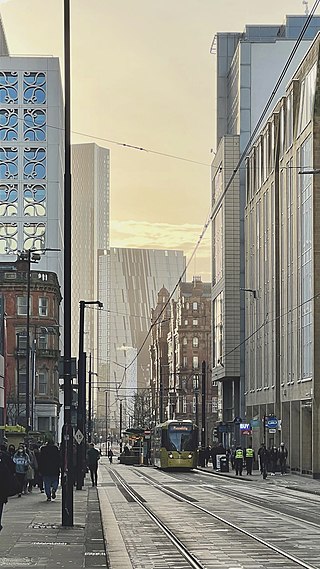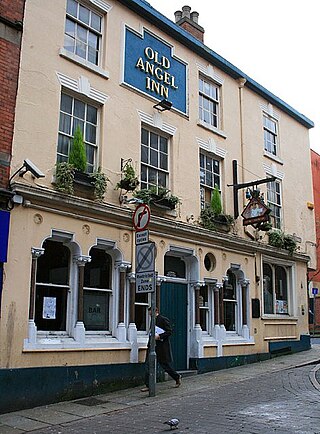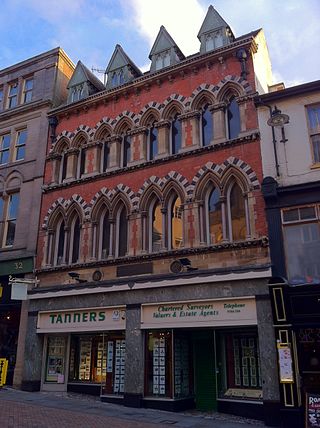 Stoney Street, looking north | |
| Maintained by | Nottingham City Council |
|---|---|
| Coordinates | 52°57′6.65″N1°8′33.72″W / 52.9518472°N 1.1427000°W |
Stoney Street is an historic street in Nottingham City Centre between High Pavement and Carlton Street.
 Stoney Street, looking north | |
| Maintained by | Nottingham City Council |
|---|---|
| Coordinates | 52°57′6.65″N1°8′33.72″W / 52.9518472°N 1.1427000°W |
Stoney Street is an historic street in Nottingham City Centre between High Pavement and Carlton Street.
The street is medieval and formed the north to south spine of the Saxon town. [1]
For many years the street was a cul-de-sac, terminating before the current junction with High Pavement. [2] It was a residential street by the eighteenth century, containing some fine mansions including Plumptre House and Pierrepont House.
During the 19th century, the residential properties were replaced by Lace factories and these buildings still dominate the street.

The Lace Market is a historic quarter-mile square area in the centre of Nottingham, England. It was the centre of the world's lace industry during the British Empire and is now a protected heritage area. It was an area of salesrooms and warehouses for storing, displaying and selling the lace. The Lace Market adjoins Hockley, and both areas now accommodate a variety of bars, restaurants and shops.

Bridlesmith Gate is a pedestrianised shopping street in the city centre of Nottingham, England. It is located between Middle Pavement and Victoria Street. St. Peter's Gate and Bottle Lane stem off it along with Byard Lane.

Thomas Chambers Hine was an architect based in Nottingham.
Richard Charles Sutton was an architect based in Nottingham. He was born 1834 and died on 18 October 1915.

The Black-and-white Revival was a mid-19th-century architectural movement that revived historical vernacular elements with timber framing. The wooden framing is painted black and the panels between the frames are painted white. The style was part of a wider Tudor Revival in 19th-century architecture.

Mosley Street is a street in Manchester, England. It runs between its junction with Piccadilly Gardens and Market Street to St Peter's Square. Beyond St Peter's Square it becomes Lower Mosley Street. It is the location of several Grade II and Grade II* listed buildings.

High Pavement is a street in Nottingham in Nottinghamshire, England. It is one of the earliest streets in the city, and most of its buildings are listed.

Captain Gilbert Smith Doughty CE was an architect based in Nottingham and Matlock.

Samuel Dutton Walker F.S.A. was an architect based in Nottingham.

John Howitt FRIBA was an architect based in Nottingham.

William Dymock Pratt was an architect based in Nottingham, England

The Old Angel Inn is a Grade II listed public house in the Lace Market, Nottingham.

Robert Evans FRIBA, JP was an English architect based in Nottingham.

William Jolley was an English architect based in Nottingham.

Castle Gate is an historic street near the centre of the English city of Nottingham. The street runs uphill, from a junction with Low Pavement, Lister Gate and Albert Street in the city centre, to Castle Road, near to the entrance to Nottingham Castle. The street is noted for its Georgian houses, many of which are listed buildings. There is also a complex of rock-cut caves, under buildings at the lower end of the street, which is a scheduled monument.

St Mary’s Gate is a historic street in the Lace Market area of Nottingham City Centre between High Pavement and Warser Gate.

Pelham Street is an historic street in Nottingham City Centre between High Street and Carlton Street.

Lawrence Bright was an architect based in Nottingham.

Francis Williamson was a British surveyor and architect based in Nottingham.
Bridge ward is an electoral ward in the city of Nottingham, England. The ward contains over 270 listed buildings that are recorded in the National Heritage List for England. Of these, two are listed at Grade I, the highest of the three grades, 18 are at Grade II*, the middle grade, and the others are at Grade II, the lowest grade. The ward includes the centre of the city, and the area to the south towards the River Trent. The districts contained in the ward include Nottingham city centre, Lace Market and The Meadows.